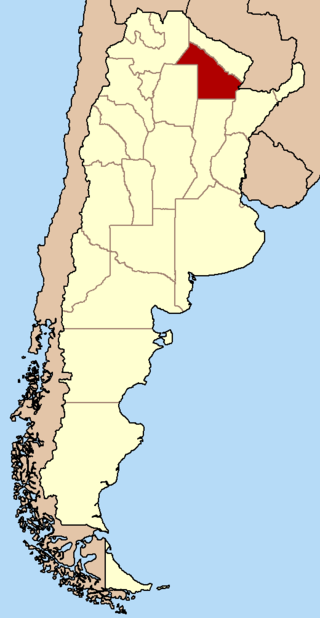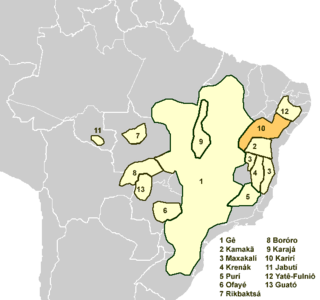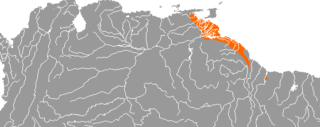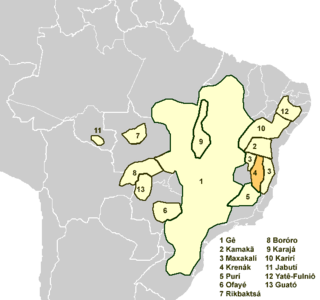Related Research Articles

The Misumalpan languages are a small family of languages spoken by indigenous peoples on the east coast of Nicaragua and nearby areas. The name "Misumalpan" was devised by John Alden Mason and is composed of syllables from the names of the family's three members Miskito, Sumo languages and Matagalpan. It was first recognized by Walter Lehmann in 1920. While all the languages of the Matagalpan branch are now extinct, the Miskito and Sumu languages are alive and well: Miskito has almost 200,000 speakers and serves as a second language for speakers of other indigenous languages in the Mosquito Coast. According to Hale, most speakers of Sumu also speak Miskito.

Mochica is an extinct language formerly spoken along the northwest coast of Peru and in an inland village. First documented in 1607, the language was widely spoken in the area during the 17th century and the early 18th century. By the late 19th century, the language was dying out and spoken only by a few people in the village of Etén, in Chiclayo. It died out as a spoken language around 1920, but certain words and phrases continued to be used until the 1960s.

Barbacoan is a language family spoken in Colombia and Ecuador.

The Maxakalían languages were first classified into the Jê languages. It was only in 1931 that Čestmír Loukotka separated them from the Jê family. Alfred Métraux and Curt Nimuendajú considered the Maxakalían family isolated from others. John Alden Mason suggests a connection with the Macro-Jê stock, confirmed by Aryon Rodrigues.

Tacanan is a family of languages spoken in Bolivia, with Ese’ejja also spoken in Peru. It may be related to the Panoan languages. Many of the languages are endangered.

Lule is an indigenous language of northern Argentina.
The Piaroa–Saliban, also known as Saliban, are a small proposed language family of the middle Orinoco Basin, which forms an independent island within an area of Venezuela and Colombia dominated by peoples of Carib and Arawakan affiliation.

Cuiba or Cuiva is a Guahiban language that is spoken by about 2,300 people in Colombia and additional 650 in Venezuela. More than half of Cuiba speakers are monolingual, and in Colombia there is a 45% literacy rate. Cuiva is also referred to as Cuiba, Cuiba-Wámonae, Kuiva, Chiricoa, Hiwi, and Maiben. In Colombia, Cuiva is spoken among those who live and who are born surrounding the Colombian rivers, Meta Casanare and Capanaparo. The Cuiba ethnic group is often found in the Casanare Department. In Venezuela the language is spoken in the state of Apure, one of the state border with Colombia, which is found alongside the Capanaparo river.

The Uwa language, Uw Cuwa, commonly known as Tunebo, is a Chibchan language spoken by between 1,800 and 3,600 of the Uwa people of Colombia, out of a total population of about 7,000.
Andaqui is an extinct language from the southern highlands of Colombia. It has been linked to the Paezan or Barbacoan languages, but no connections have been demonstrated. It was spoken by the Andaqui people of Colombia.
Maipure, was a language once spoken along the Ventuari, Sipapo, and Autana rivers of Amazonas and, as a lingua franca, in the Upper Orinoco region. It became extinct around the end of the eighteenth century. Zamponi provided a grammatical sketch of the language and furnished a classified word list, based on all of its extant eighteenth century material. It is historically important in that it formed the cornerstone of the recognition of the Maipurean (Arawakan) language family.
Aikanã is an endangered language isolate spoken by about 200 Aikanã people in Rondônia, Brazil. It is morphologically complex and has SOV word order. Aikanã uses the Latin script. The people live with speakers of Koaia (Kwaza).

The Karirí languages, generally considered dialects of a single language, were a group of languages formerly spoken by the Kiriri people of Brazil. It was spoken until the middle of the 20th century; the 4,000 ethnic Kiriri are now monolingual Portuguese speakers, though a few know common phrases and names of medicinal plants.

Warao is the native language of the Warao people. A language isolate, it is spoken by about 33,000 people primarily in northern Venezuela, Guyana and Suriname. It is notable for its unusual object–subject–verb word order. The 2015 Venezuelan film Gone with the River was spoken in Warao.

The Aimoré, Botocudoan or Borum languages, now sometimes known as Krenakan after the last one remaining, are a branch of the Macro-Jê languages - spoken mainly in Brazil - including moribund Krenak and extinct languages such as Guerén and Nakrehé. Loukotka (1968) considered them dialects of a single language, but more recent treatments describe at least some of them as separate languages.
The Yaruro language is an indigenous language spoken by Yaruro people, along the Orinoco, Cinaruco, Meta, and Apure rivers of Venezuela. It is not well classified; it may be an isolate, or distantly related to the extinct Esmeralda language.

Guamo is an extinct language of Venezuela. Kaufman (1990) finds a connection with the Chapacuran languages convincing.

Otomaco and Taparita are two long-extinct languages of the Venezuelan Llanos.
Gamelaa.k.a.Curinsi or Acobu, is an unclassified and presumably extinct language of the Maranhão region of Northeastern Brazil. It was originally spoken along the Itapecuru River, Turiaçu River, and Pindaré River, with ethnic descendants reported to be living in Cabo and Vianna in Maranhão State.
The Yuruna languages of Brazil form a branch of the Tupian language family.
References
- ↑ Zamponi, Raoul (2017). Betoi-Jirara, Sáliban, and Hod i: Relationships among Three Linguistic Lineages of the Mid-Orinoco Region. Anthropological Linguistics, Volume 59, Number 3, Fall 2017, pp. 263-321.
- ↑ Epps, Patience; Michael, Lev, eds. (2023). Amazonian Languages: Language Isolates. Volume I: Aikanã to Kandozi-Chapra. Berlin: Walter de Gruyter. ISBN 978-3-11-041940-5.
- ↑ Loukotka, Čestmír (1968). Classification of South American Indian languages . Los Angeles: UCLA Latin American Center.
- ↑ Zamponi, Raoul. 2003. Betoi. Languages of the World, 428. München: Lincom Europa.